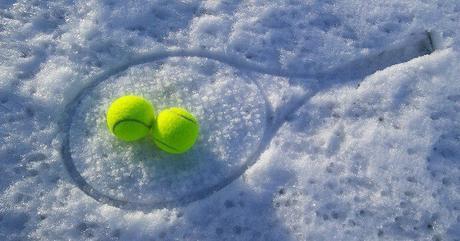
We have such fickle fall weather here in Texas; it can be a fabulous 80 degrees one day, and a frigid 40 degrees the next. Yesterday morning, I played a fun yet competitive match in the latter, and because I incorporated all of these great tips into my game, I won!
Give these a try, and you'll see more success on the courts this winter:
Dress for success
For those of us who don't have access to warm-n-cozy indoor courts, it's important to dress for playing tennis outdoors. Wear several thin layers of clothing, so you can take them off as you warm up. Since I prefer playing without sleeves, I'll still wear my sleeveless tennis top, though I'll wear a thin long sleeve top over it. And if it's really cold, I'll also wear my favorite Nike jacket. This way, if it's too cold to remove any layers, my movement won't be hindered by bulky clothing. And while it's important to keep your body warm, it's equally important to do so for your hands.
It's a sad fact of winter tennis that the colder your hands are, the harder it is to find the right position for your grip. Some players wear gloves to keep their hands warm, but I just can't. I find it extremely difficult to feel my grip through the gloves, no matter how thin they are; however, I will slip them on during the change-overs for a quickie warm up.
Something else to consider wearing is a pair of polarized sunglasses. The winter sun sits lower in the sky, and is more likely to be a bother. If you aren't used to wearing sunglasses, they will take a little getting used to, but if they can keep the sun out of your eyes so you can rip a winner, I'd say it's well worth it.
Stre-e-e-e-etch it out
If you only take away one thing from this post, it must be this: be sure and stretch at home, before you get to the courts, and then stretch again before you get on the court. Our muscles take a lot longer to warm up in the cold, so it's important to stretch them and get them warmed up before putting them through the rigors of a tennis match. If not done properly, you risk all sorts of muscle injuries, which could keep you off the courts for a long time.
The best shots for cold-weather tennis
Without the sweltering summer heat and humidity, you're more likely to make it through that third set and play longer rallies without feeling like you're going to pass out. And while it's important to keep in mind that the colder weather will have an impact on the way you play, it will also have an affect on the ball as well: the colder the weather is, the less bounce the ball will have. That being said, these are the three most effective shots you can play in cold weather:
- Drop shots: On a warm day, a well-placed drop shot can be extremely difficult to return; on a cold day, it can be lethal. Take advantage of the heavier bounce and use the drop shot often.
- Slice: Incorporate more slice into both your groundies and approach shots. This will keep the ball extra low and really force your opponent to get under the ball and hit a passing shot, which is easier said than done. With the ball being a little flatter, be sure to aim deeper and hit harder to keep the ball from landing too short and allowing your opponent to step into the court to hit the ball.
- Flat serves and slice serves: These serves will also force your opponent to have to get down for the lower balls. Topspin serves won't be as effective due to the heavier bounce taking away much of the kick. As with the slice, hit deeper and harder.
While these are great tactics, you need to realize that your opponent can also use them against you. If that happens, you need to make sure you prepare early and get your racket back, starting your back swing a little lower than you normally would, and bending at the knees so you can really get down and under the ball.
Move it or lose it
In case your opponent uses the above shots against you, stay ready to move forward so you can get quickly get to those drop shots and short balls. Also, make sure to bring your racket back early for good preparation, and start your back swing a little lower than you normally would to adjust to the lower bounce.
Other shots, like your topspin, won't be as effective in winter. If you have a big kick or topspin serve beware: the cold weather will take some of the kick/bounce out of the ball.
Restring your racket
The pace of a ball is determined by several factors, including the bounce of the ball. With a diminished bounce in colder temps, the ball will naturally come off the racket slower, making it harder to generate more pace. To offset that, I recommend stringing your racket 2 pounds lower in winter.
Why would that make a difference?
In general, rackets strung on the lower end of the tension range provide more power than tightly strung rackets. When you hit a tennis ball, the impact causes the strings to deform or stretch. Energy from that impact is stored in the strings and then returned to the ball as it rebounds off your racket. Loose strings stretch more than tight strings and therefore, store more energy; so, when the energy is returned to the ball, you have a more powerful shot.
These are just a few quick tips that will help you compensate for the flatter balls this winter. So, layer up and get out on those courts... and win more winter matches!


